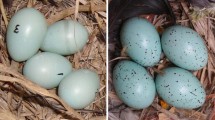Summary
Intraspecific nest parasitism in the swallow Hirundo rustica involves several parasite and anti-parasite tactics. Neighboring swallows breed asynchronously, perhaps because neighboring nests with overlapping egg-laying periods have higher frequency of intraspecific nest parasitims than neighboring nests with no such overlap. Since nest guarding prevents nest parasitism, the effect of nest guarding was removed by putting up old swallow nests. Such experimental nests were parasitized by swallows more often when the nests contained eggs, than when empty, and when the nests were far away from, rather than close to, an active neighboring nest. Close experimental nests with eggs were, however, parasitized less frequently if asynchronous (non-overlapping egg-laying periods), rather than synchronous, to active neighboring nests. Aggressive anti-parasite behavior of nest owners was determined from responses towards female intruders. Responses were more often aggressive before and especially during egg laying than during incubation. Nest owners also behaved aggressively more often when the intruder approached close to as compared to at some distance from their nest. Focal pairs behaved aggressively more often towards closely approaching intruders during the incubation period than towards distantly approaching intruders during the egg-laying period. Swallows reduce the frequency of intraspecific nest parasitism by nesting asynchronously with and close to a neighboring nest. Aggression by neighbors may reduce the success of potential parasitic swallows.
Similar content being viewed by others
References
Andersson M (1984) Brood parasitism within species. In: CJ Barnard (ed) Producers and scroungers. Chapman and Hall, London, pp 195–228
Andersson M, Eriksson MOG (1982) Nest parasitism in goldeneyes Bucephala clangula: some evolutionary aspects. Am Nat 120:1–16
Bishop YMM, Fienberg SE, Holland PW (1975) Discrete multivariate analysis: theory and applications. MIT Press, Cambridge, Mass
Brown CR (1984) Laying eggs in a neighbour's nest: benefit and cost of colonial living in swallows. Science 224:518–519
Brown CR, Brown MB (1988) A new form of reproductive parasitism in cliff swallows. Nature 331:66–68
Karlsson J (1983) Breeding of the starling (Sturnus vulgaris). Ph.D. thesis, University of Lund, Lund, Sweden
Kendeigh SC (1952) Parental care and its evolution in birds. Illinois Biol Monogr 22:1–358
Lanier GA Jr (1982) A test for conspecific egg discrimination in three species of colonial passerine birds. Auk 99:519–525
Møller AP (1985) Mixed reproductive strategy and mate guarding in a semi-colonial passerine, the swallow Hirundo rustica. Behav Ecol Sociobiol 17:401–408
Møller AP (1987a) Intraspecific nest parasitism and anti-parasite behaviour in swallows, Hirundo rustica. Anim Behav 35:247–254
Møller AP (1987b) Advantages and disadvantages of coloniality in the swallow, Hirundo rustica. Anim Behav 35:819–832
Møller AP (1988a) Infanticidal and anti-infanticidal strategies in the swallow Hirundo rustica. Behav Ecol Sociobiol 22:365–371
Møller AP (1988b) Female choice selects for male sexual tail ornaments in the monogamous swallow. Nature 332:640–642
Payne RB (1977) The ecology of brood parasitism in birds. Ann Rev Ecol Syst 8:1–28
Ricklefs RE, Smeraski CA (1983) Variation in incubation period within a population of the European starling. Auk 100:926–931
Siegel S (1956) Nonparametric statistics for the behavioral sciences. McGraw-Hill Kogakusha, Tokyo
Trivers RL (1971) The evolution of reciprocal altruism. Q Rev Biol 46:35–57
Wittenberger JF, Hunt GL (1985) The adaptive significance of coloniality in birds. In: DS Farner, JR King, KC Parkes (eds) Avian biology. Vol 8. Academic Press, Orlando, pp 1–78
Yom-Tov Y (1980) Intraspecific nest parasitism in birds. Biol Rev 55:93–108
Author information
Authors and Affiliations
Rights and permissions
About this article
Cite this article
Møller, A.P. Intraspecific nest parasitism in the swallow Hirundo rustica: the importance of neighbors. Behav Ecol Sociobiol 25, 33–38 (1989). https://doi.org/10.1007/BF00299708
Received:
Accepted:
Issue Date:
DOI: https://doi.org/10.1007/BF00299708




